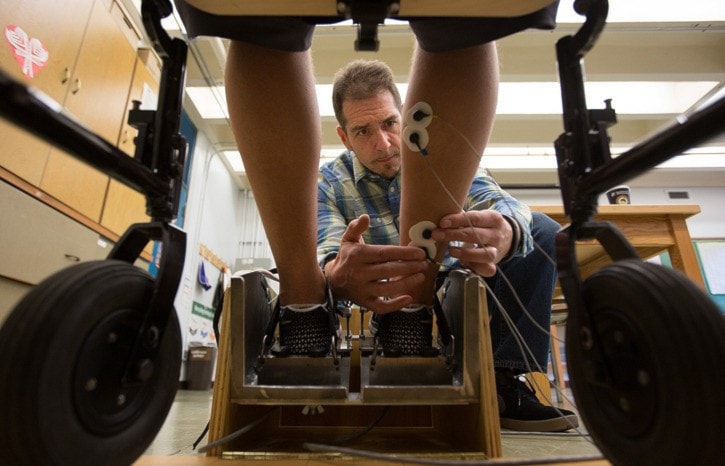Research at the University of Victoria has demonstrated that weight training by stroke victims in recovery can have twice the benefit to their bodies.
A study led by UVic neuroscientist Paul Zehr showed that showed that a stroke patient exercising the strong side of their body will have roughly equivalent muscle gain on their weak side.
"One of the things that is a big problem after a stroke is one side is more affected," Zehr said. "We are trying to understand what has happened after the stroke, and take that information an use it to guide interventions B��Ԫ������ַ� to help push the system back (to normal)."
The study, focusing primarily on the lower body to help patients regain strength and mobility, showed improvements in the injured side of the body as roughly equivalent to the uninjured side. Overall, people who participated in the six-week study gained about 30 per cent muscle mass.
Cross-education of strength, or the idea that training one side of the human body can have benefits to corresponding muscles on the opposite side, has been known for decades - but typically the cross-benefit is only five to 10 per cent.
"A lot of times when you study the human nervous system and you try to translate that to a clinical populations, it doesn't always translate," Zehr said.
"The really important observation was when we went to see what happened to the leg not trained, we found the same strength gain which means 30 per cent (gain) on both sides."
Nineteen post-stroke patients ranging in age from 26 to 81 and averaging 84 months post-stroke, completed the full six-week program that involved high-intensity exercises, such as lifting a fitted block of wood with their unaffected ankle and foot. While more tests are being done, the results of the study, completed with PhD student Katie Dragert, startled even the professor.
"What is happening (is) there are connections across the brain and spinal cord that is spilling over to help the other side," Zehr said. "We know this works in people without damage B��Ԫ������ַ� but not only did it work it outstripped any expectation on how it would work. The fact it had equivalent strength gains on both sides is a remarkable result."
Retired school secretary Barb Oliver was one of those patients, having had a stroke 11 years ago. She said studies like this are important both for her and future stroke victims to live their lives and do the things they want to do.
"While I was doing it I noticed the difference," Oliver said. "My muscles were looser, not as tight."
The 61-year-old is fresh off a trip to Africa in the fall, despite the misgivings of her travel agent, who suggested Africa was no place for a "disabled person." She went anyway and hopes others can do the same as research into post-stroke patients continue.
"I went and had the time of my life. It is the hope you get stronger and use less of the health care system and less medication," Oliver said. "Dr. Zehr's program and the work of all the PhD students are wonderful up there and great to work with. I would recommend anybody to do it."
Zehr and the PhD students hope more post stroke patients get involved and believe their research is making a difference.
"It is a piece of a number of different puzzles, what we do now is refine it and maximize it," Zehr said. "It is a way to make that intervention better. The bigger overarching vision is to help restore and recover walking ability."
Post-stroke patients looking to be involved in future studies can contact them at rnl@uvic.ca.
reporter@vicnews.com



